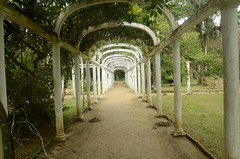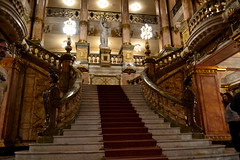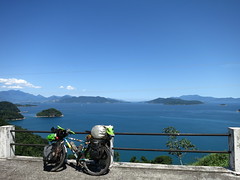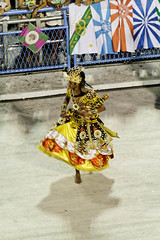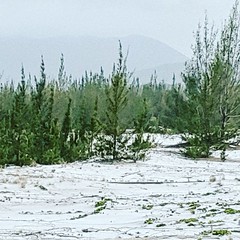Rio de Janeiro
Rio de Janeiro (Portuguese: [ˈʁi.u d(ʒi) ʒɐˈne(j)ɾu]) is one of the 27 federative units of Brazil. It has the second largest economy of Brazil, with the largest being that of the state of São Paulo. The state, which has 8.2% of the Brazilian population, is responsible for 9.2% of the Brazilian GDP.
The state of Rio de Janeiro is located within the Brazilian geopolitical region classified as the Southeast (assigned by IBGE). Rio de Janeiro shares borders with all the other states in the same Southeast macroregion: Minas Gerais (N and NW), Espírito Santo (NE) and São Paulo (SW). It is bounded on the east and south by the South Atlantic Ocean. Rio de Janeiro has an area of . Its capital is the city of Rio de Janeiro, which was the capital of the Portuguese Colony of Brazil from 1763 to 1815, of the following United Kingdom of Portugal, Brazil and the Algarves from 1815 to 1822, and of later independent Brazil as a kingdom and republic from 1822 to 1960.
The state's 22 largest cities are Rio de Janeiro, São Gonçalo, Duque de Caxias, Nova Iguaçu, Niterói, Campos dos Goytacazes, Belford Roxo, São João de Meriti, Petrópolis, Volta Redonda, Magé, Macaé, Itaboraí, Cabo Frio, Armação dos Búzios, Angra dos Reis, Nova Friburgo, Barra Mansa, Barra do Piraí, Teresópolis, Mesquita and Nilópolis.
Rio de Janeiro is the smallest state by area in the Southeast macroregion and one of the smallest in Brazil. It is, however, the third most populous Brazilian state, with a population of 16 million people in 2011 (making it the most densely populated state in Brazil) and has the third longest coastline in the country (after those of the states of Bahia and Maranhão).
In the Brazilian flag, the state is represented by Mimosa, the beta star in the Southern Cross (β Cru).
Demonym
The original demonym for the State of Rio de Janeiro is fluminense, from Latin flumen, fluminis, meaning "river". While carioca (from Old Tupi) is an older term, first attested in 1502, fluminense was sanctioned in 1783, twenty years after the city had become the capital of the Brazilian colonies, as the official demonym of the Royal Captaincy of Rio de Janeiro and subsequently of the Province of Rio de Janeiro. From 1783 through the Imperial Regime, carioca remained an unofficial term which other Brazilians used for the inhabitants of the city as well as the province. During the first years of the Brazilian Republic, carioca came to be the name given to those who lived in the city's slums or a pejorative used to refer to the bureaucratic elite of the Federal District. Only when the city lost its status as Federal District (to Brasília) and became the State of Guanabara in 1960 did carioca become an official demonym along with guanabarino. In 1975, Guanabara State was incorporated into Rio de Janeiro State, becoming the present City of Rio de Janeiro. Carioca became the demonym of the city, while fluminense continues to be used for the state as a whole.
History
Hereditary captainships
European presence in Rio de Janeiro dates back to 1502. Rio de Janeiro originated from parts of the captainships of de Tomé and São Vicente. Between 1555 and 1567, the territory was occupied by the French, who intended to install a colony, France Antarctique. Aiming to prevent the occupation of the Frenchmen, in March 1565, the city of Rio de Janeiro was established by Estácio de Sá.
In the 17th century, cattle raising and sugar cane cultivation stimulated the city's progress, which was definitively assured when the port started to export gold extracted from Minas Gerais in the 18th century. In 1763, Rio de Janeiro became the capital of Colonial Brazil. With the flight of the Portuguese royal family from Portugal to Brazil in 1808, the region soon benefited from urban reforms to house the Portuguese. Chief among the promoted changes were the transformation of agencies of public administration and justice, the creation of new churches and hospitals, the foundation of the first bank of the country (the Bank of Brazil) and the Royal Press, with the Gazette do Rio of Janeiro. The following years witnessed the creation of the Jardim Botânico (Botanical Garden) and the .
There followed a process of cultural enhancement influenced not only by the arrival of the Royal Family, but also by the presence of European graphic artists who were hired to record the society and Brazilian natural features. During this same time, was founded as well.
The neutral city
In 1834, the city of Rio de Janeiro was transformed into a "neutral city", remaining as capital of the state, while the captainships became provinces, with headquarters in Niterói, a neighbouring city. In 1889, the city became the capital of the Republic, the neutral city became the federal district and the province a state. In 1894, Petrópolis became the capital of Rio de Janeiro, until 1902 when Niterói recovered its capital status. With the relocation of the federal capital to Brasília in 1960, the city of Rio de Janeiro became Guanabara State. Niterói remained the state capital for Rio de Janeiro state, while Rio de Janeiro served the same status for Guanabara.
The new state of Rio de Janeiro
In 1975, the states of Guanabara and Rio de Janeiro were merged under the name of Rio de Janeiro, with the city of Rio de Janeiro as state capital. The symbols of the former State of Rio de Janeiro were preserved, while the symbols of Guanabara were kept by the city of Rio de Janeiro.
Geography
The state is part of the Mata Atlântica biome and is made up of two distinct morphological areas: a coastal plain, known as baixada, and a plateau, which are disposed in parallel fashion from the shoreline on the Atlantic Ocean inland towards Minas Gerais.
The coastline extends 635 kilometers and is formed by the bays of Guanabara, Sepetiba, and Ilha Grande. There are prominent slopes near the ocean, featuring also diverse environments, such as restinga vegetation, bays, lagoons and tropical forests.
Most of the state however consists of highlands, often higher than 1000 m, formed by several mountain chains like the Serra do Mar which separates Rio from the state of São Paulo. The highest point of the state, the Pico das Agulhas Negras (Black Needles Peak) is located in the Serra da Mantiqueira which forms the physical border with neighbouring Minas Gerais.
Its principal rivers are the Guandu, the Piraí, the Paraíba do Sul, the Macaé and the Muriaé.
Vegetation and animal life
Tropical forests used to cover more than 90% of the territory of Rio; large portions were devastated for urbanization and for plantations (coffee, sugar cane); preserved areas can be found in the steepest parts of the mountain chains.
The state's tropical coast and river areas are the only remaining habitat of the golden lion tamarin.
Demographics
According to the IBGE of 2008, there were 15,772,000 people residing in the state. The population density was .
Urbanization: 96.9% (2004); Population growth: 1.3% (1991–2000).
The last PNAD (National Household Survey) census revealed the following numbers: 8,509,000 White people (54.2%), 5,302,000 Pardo (Multiracial) people (33.8%), 1,809,000 Black people (11.5%), 25,000 Asian people (0.2%), 19,000 Amerindian people (0.1%).
People of Portuguese ancestry predominate in most of the state. The Brazilian census of 1920 showed that 39,74% of the Portuguese who lived in Brazil lived in Rio de Janeiro. Including all of the Rio de Janeiro, the proportion raised to 46,30% of the Portuguese who lived in Brazil. The numerical presence of the Portuguese was extremely high, accounting for 72% of the foreigners who lived in the capital. Portuguese born people accounted for 20,36% of the population of Rio, and those with a Portuguese father or a Portuguese mother accounted for 30,84%. In other words, native born Portuguese and their children accounted for 51,20% of the inhabitants of Rio, or a total of 267664 people in 1890.
Other European ethnic groups, such as Swiss, Finnish and Germans settled mostly in the mountainous areas (Nova Friburgo, Petrópolis, etc) and in the capital. Italians and Spaniards are also present in the capital as well as in the surrounding cities.
People of African descent are numerous, particularly in the metropolitan area of the capital city. Those of mixed-race ancestry - tri-racials, mulatos ("mulato" is a mix of white and black), and some caboclos (mix of white and indigenous) and cafuzos (mix of black and indigenous) - make up the majority of the population in many cities. The city of Itaguaí was considered a Japanese colony in the 20th century, but many of the Asian Cariocas that once lived there moved overseas (most of them to Japan) as well to other Brazilian states like São Paulo.
Religion
According to the 2010 Brazilian census, there were 7,324,315 Roman Catholics (45.8%), 4,696,906 Protestants (29.4%), 647,572 Spiritists (4%), and 2,416,303 people without religion (14.6%). There are also adherents of Islam, Judaism, Buddhism, Hinduism, esoterism, neo-paganism, afro-Brazilian religions and Asian religions. Together, the adherents of these and other minorities constitute 6.2% of Rio de Janeiro's population.
Rio de Janeiro is the state with the lowest percentage of Catholics in Brazil, and the state with the highest percentage of people without religion (such as atheists and agnostics). In addition, it is the state with the highest percentage of spiritists in Brazil. The variety of denominations is a mark of the presence of religious diversity in the demographic profile of the state.
Culture
Carnival
The occasion of the last five days leading up to Lent is annually cause for a great explosion of joy in Rio – a round-the-clock party uniting emotions, creativity, plasticity, colours, sounds and much fantasy. It is the greatest popular party in the world, a unique record of the rich cultural, melting pot typical of Brazil. In Rio, it is celebrated in various ways, most famously through the elaborate competition of samba schools comprising tho…
Hotels Rio de Janeiro
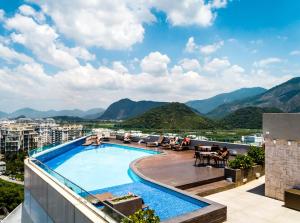 Américas Barra HotelRio de Janeiro
Américas Barra HotelRio de Janeiro Pousada Laguna HotelCabo Frio
Pousada Laguna HotelCabo Frio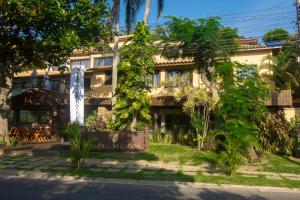 Hotel Barra da Lagoa by Latitud HotelesArmação de Búzios
Hotel Barra da Lagoa by Latitud HotelesArmação de Búzios HospedaTom - Pé na Areia e Vista Mar - Praia GrandeArraial do Cabo
HospedaTom - Pé na Areia e Vista Mar - Praia GrandeArraial do Cabo Imperatriz Paraty HotelParati
Imperatriz Paraty HotelParati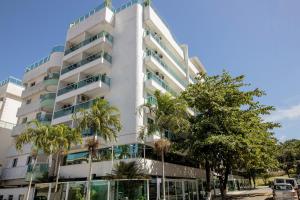 Angra Beach HotelAngra dos Reis
Angra Beach HotelAngra dos Reis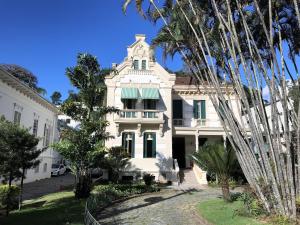 Hotel Casablanca ImperialPetrópolis
Hotel Casablanca ImperialPetrópolis Pousada Bella VistaMauá
Pousada Bella VistaMauá
Looking for places related to Rio de Janeiro?
Those are other destinations to find places related to Rio de Janeiro:









